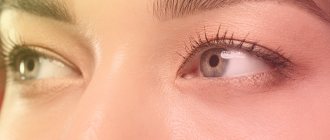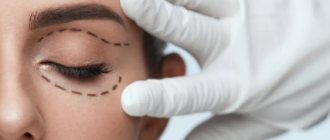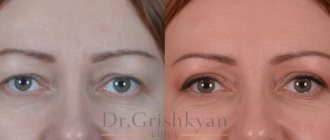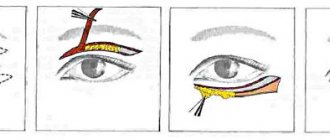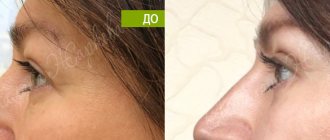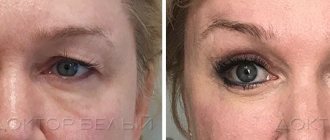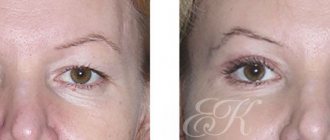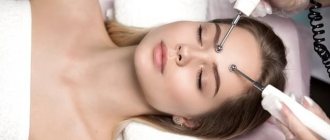Eyes are the mirror of our soul. To this undeniable idiom we can only add that the eyes are also a mirror of our age.
Do you remember how in Gogol’s fairy tale Viy asked: “Lift my eyelids”? It’s the same thing, sometimes you want to exclaim when you see your imperfect reflection in the mirror. Bags under the eyes, puffiness, pigmentation, drooping eyelids, sagging and wrinkles do not make us look good at all.
Fortunately, it is possible and necessary to combat these defects.
Expert comment:
“If the problem is not limited to a couple of wrinkles in the corners of the eyes, you will most likely be recommended laser blepharoplasty.
Eyelid laser is a very good and effective procedure, with one caveat, however: the words “laser blepharoplasty” hide three different procedures at once. One of them is surgical, and two are non-surgical.”
Anna Smirnova, dermacosmetologist.
In this article we will explain in detail what is behind the words “laser blepharoplasty”.
What is fractional laser treatment?
Lasers operate in different modes, not just scalpel mode.
The essence of the fractional mode is that the laser beam is divided into many small beams (from 100 to 1,000). When treating the eyelid area, the laser makes microscopic holes around the eyes - nanoperforations.
Light spots are holes in the skin after exposure to a fractional laser.
These laser procedures are called “laser eyelid surgery” or “non-surgical laser blepharoplasty.”
In this case, fractional eyelid blepharoplasty is not a surgical procedure. The effect occurs only on the skin. There are no incisions and usually only local anesthesia is used.
The words "plasty" and "blepharoplasty" for this procedure are used to emphasize the surgical-like effect that modern fractional lasers have on the skin around the eyes.
How is non-surgical blepharoplasty performed?
In modern cosmetology, the most commonly used method for anti-aging procedures is fractional exposure , in which the laser beam does not move in a continuous line, treating the entire surface of the skin, but in a targeted manner.
So-called microwells (columns) are formed, visually on the skin this appears as a network of white dots (white is the dry residue of evaporated skin proteins: collagen and elastin).
Due to the temperature, the skin tightens, and the process of regeneration of new skin structures starts in the affected areas; in fact, new young skin is formed with newly restored collagen and elastin.
It has been proven that the technique is as effective as continuous resurfacing , while it is less painful and traumatic, and also has a shorter recovery period.
The result of non-surgical eyelid blepharoplasty is:
- Smoothing out fine wrinkles and reducing the area of skin flap in the treated area.
- Improving skin turgor and tone. The manifestations of ptosis are significantly reduced, the eyelid is tightened, and the gaze becomes more open.
- Increased skin elasticity. Thermal exposure leads to a double effect: on the one hand, collagen and elastin fibers are twisted into tight spirals, providing the effect of skin contraction and a dense frame. On the other hand, such exposure stimulates the formation of new cells.
- Thermal effects improve blood circulation and lymphatic drainage, which helps fight congestion.
The laser blepharoplasty procedure is performed under local anesthesia and takes from 40 to 60 minutes (including anesthesia). It does not require a hospital stay, and therefore the patient can immediately go home.
There are two types of fractional eyelid lifting with laser
The fractional impact can be deep - from 150 to 1,000 microns - and reach the level of the dermis. This procedure is called laser resurfacing.
The superficial impact of a laser from 50 to 150-200 microns in depth is called laser peeling.
The effect of the procedure differs depending on the depth of exposure, which we will discuss further.
Early and late complications after lower blepharoplasty
Patients who have undergone blepharoplasty on the lower eyelids should understand that, like any other operation, eyelid surgery is associated with risks of developing postoperative complications. They are divided into 2 large categories:
- early postoperative complications;
- late complications after lower blepharoplasty.
Complications after lower blepharoplasty in the early period
Develop immediately after surgery. These include:
- postoperative tissue swelling;
- headache;
- blurred vision;
- pain in the eyes;
- bruises;
- soreness when touched;
- thickening of the skin on the lower eyelids.
All of these listed symptoms are the norm, without which lower blepharoplasty is impossible. Rehabilitation and strict adherence to the recommendations of the plastic surgeon in the postoperative period will help relieve these manifestations.
If after lower eyelid surgery such symptoms do not go away within 5 days, you should consult a plastic surgeon. The doctor will examine the lower eyelids, taking into account the individual characteristics of the patient. If necessary, prescribe treatment.
Late complications after eye surgery
Unfortunately, the results after lower eyelid blepharoplasty do not always meet patients’ expectations. Often, after completion of the rehabilitation period, long-term complications develop in the form of:
- Excessive tearing of the eyes and photophobia
. These symptoms develop because the lacrimal openings are displaced outward during surgery. Another possible cause of the complication is a narrowing of the tear duct caused by improper tissue scarring. - Formation of a rough scar
. Very often, patients' sutures come apart, which leads to the need for repeated stitches. As a result, the risk of tissue scarring increases when the skin re-occurs. - Incomplete closure of the eyelids
is a complication that lower blepharoplasty often leads to: photos before and after an unsuccessful operation can be found on the Internet. They will allow you to evaluate the difference between the initial condition of the eyes and the result of surgical correction. When this complication develops, the patient is indicated for repeated blepharoplasty, since the eyes cannot be fully hydrated, which leads to the development of more serious eye diseases. - Eye asymmetry.
The complication develops due to improper suture application or tissue scarring. Asymmetry can only be eliminated surgically. - Cyst on the line of suture formation
. In some patients they resolve on their own. Otherwise, the plastic surgeon excises the tumor during surgery.
Complications after lower eyelid blepharoplasty develop in patients extremely rarely. To avoid being one of these “lucky” people, you should be especially careful when choosing a plastic surgeon and an aesthetic surgery clinic.
Meaning 2. Laser blepharoplasty is laser resurfacing of the eyelids
In our clinic, laser eye resurfacing is performed using the Eraser-C CO2 laser. Laser eyelid lifting is a very effective procedure, during which the laser makes several thousand nanoholes around the eyes to a depth of more than 150 microns.
Resurfacing with the Eraser-C laser affects several factors of youth at once:
- stimulates the layer of collagen in the skin. Its fibers begin to twist into spirals, causing the skin to contract and tighten.
- the body mobilizes forces to fight the damage - the microtubules from the laser begin to tighten. This gives a strong skin lifting effect, visible to the naked eye immediately after the procedure.
- at the site of the microtubules, the process of neocollagenesis begins. New collagen fibers form a new skin framework. The skin becomes thicker and its color improves.
Reduction of the skin of the lower eyelids after fractional laser resurfacing.
After the procedure, redness and swelling are observed for 7-10 days, and the skin peels off.
During the entire rehabilitation period, you will need to use special sun protection creams and avoid it for a month until the skin color in the area of resurfacing is completely restored.
Laser eye resurfacing is very effective for rejuvenating “aging” skin with pigmentation - laser energy affects melanocytes and significantly brightens the area around the eyes, eliminating dark circles under the eyes.
Laser eyelid lift produces a very noticeable skin tightening effect after the procedure, comparable to pinching circumferential blepharoplasty, and removes up to 2 mm of excess skin.
Other indications for grinding:
- wrinkles and creases of any depth,
- unevenness and sagging skin,
- first bags under the eyes,
- dull and tired skin.
The final result of rejuvenation after resurfacing can be assessed after 2-4 months, during which the effect gradually increases. The skin becomes dense, uniform in color, smooth and soft, especially in the lower eyelid area.
Separately, it is worth noting the good effect of using laser resurfacing after blepharoplasty using the surgical method. It is recommended to polish the postoperative scar after removing excess upper eyelids with a laser.
Who is the procedure suitable for?
Non-surgical blepharoplasty can be performed at any age , for both men and women. It is great for correcting imperfections caused by aging.
The procedure can also be used on young people whose drooping eyelid is a consequence of physiological characteristics. Thus, laser blepharoplasty is popular among people of Asian appearance , where sagging skin of the upper eyelid begins to appear at a young age.
If you have a hereditary predisposition in the form of low eyebrows and sagging skin, then after 35-40 years we recommend performing light laser procedures as a preventive measure.
Summarize. Laser eyelid resurfacing is currently the only non-invasive method of blepharoplasty for grade 1 and 2 ptosis. It takes place with a minimal rehabilitation period, so within a week you can return to your normal lifestyle.
But the laser does not always help. Make an appointment with the doctors at our clinic to get advice and find out what can be done in your case.
Meaning 3. Laser blepharoplasty is laser peeling around the eyes
For laser peeling at Platinental we use the Asclepion Dermablate erbium fractional laser (Germany).
In this case, the penetration of a beam of thin laser beams is carried out to a depth of 50 to 150-200 microns. The impact of the laser is less deep than with resurfacing, so rehabilitation after the procedure is much faster.
Due to the effect of uniform light refraction, the skin after laser peeling looks radiant and healthy. The laser allows you to remove old layers of the epidermis in the area of the delicate skin of the eyelids with micron precision. Laser peeling under the eyes gives the best results: improves skin color, reduces circles under the eyes, eliminates swelling and puffiness, tightens the skin and tightens it.
This method of fractional exposure does not require long-term rehabilitation - skin redness and uniform peeling disappear within just 72 hours and allows you to return to your normal lifestyle. Peeling is ideal for people with early age-related skin changes.
Laser peeling of the eye area is indicated in the following cases:
- wrinkles and folds of small depth, “crow’s feet”,
- hyperpigmentation, sallow complexion,
- loss of natural elasticity of the skin,
- spider veins,
- uneven skin,
- skin dehydration.
It should be remembered that the procedure is not done in active sun, so the best time for peeling is early spring and late autumn.
You don't have to immediately start with a deep laser resurfacing procedure under the eyes. You can perform 3-4 peeling procedures over the course of a year with an interval of 3 months and in most cases obtain a comparable effect.
Preparation for non-surgical blepharoplasty and actions during the rehabilitation period
Laser eyelid rejuvenation has a minimum of contraindications and does not require complex preparation. A specialist may refuse to perform the procedure if you have eye diseases, the presence of cancer, autoimmune, or neurological diseases, and may also recommend a delay if you are pregnant, breastfeeding, or have a fresh tan. In other cases, before the session you must adhere to the following rules:
- protect the skin from ultraviolet radiation for two weeks before the procedure;
- do not do peelings during this period and do not use cosmetics with acids;
- the day before the procedure, do not drink alcohol and avoid intense exercise.
A responsible attitude to the process will allow you to get maximum results and minimize the risk of complications!
The procedure does not cause serious discomfort. Due to the action of anesthetics, a burning sensation or a feeling of heating of the tissues may be felt. After completion of the session, the normal reaction is redness, slight swelling and a feeling of hyperthermia.
What is the effect of laser blepharoplasty of the upper eyelids?
If it is necessary to remove only small excess skin, sagging, and facial wrinkles, then laser lifting of the upper eyelids in fractional mode will be the best choice. In this case, gentle rejuvenation will give a good effect of shrinking and refreshing the skin, and there is no need to “go under the knife.”
However, if there is significant excess skin on the upper eyelid, laser removal of the drooping eyelid can only be done surgically.
The laser after blepharoplasty is used on the upper eyelid in grinding mode to mask the seam.
Rehabilitation after eyelid surgery
Rehabilitation after blepharoplasty is quick, easy and painless. There are usually no complications. Cooling pads are used to prevent swelling in the first hours after surgery.
The recovery period after an eyelid lift can last 7-14 days, and most patients can return to work within a week after surgery. In addition to regular antibiotics after surgery, patients are prescribed sterile drops to moisturize and cleanse the eyes, since in some (rather rare) cases, temporary eye dryness or discomfort may be felt, which soon passes.
The main difference and advantage of blepharoplasty performed in the clinic of plastic surgeon Kudinova is the most natural result and the virtual complete absence of noticeable traces of the scalpel. In addition, we ensure that our patients maintain their individual shape and shape of the eyes.
The incisions are minimal and hidden either by the crease of the upper eyelid or by the lash line of the lower eyelid. In addition, when performing blepharoplasty, Dr. Kudinova uses the author’s “hidden suture” technique, which was developed specifically for this operation.
What is the effect of laser blepharoplasty of the lower eyelids?
Bags under the eyes are perhaps the most noticeable signs of age.
But few people know that often hernias under the eyes are not such at all. Hernias occur as a result of protrusion of infraorbital fat. Often bags under the eyes are associated only with stagnation of fluid, and such formations are called pseudohernias.
Fractional laser resurfacing around the eyes always stimulates blood circulation, lymph flow and the formation of new healthy vessels. Metabolism and nutrition of the skin improves significantly and manifests itself on the face with a strong “drying” effect.
But not only “drying”. As a rule, dark circles form under the eyes as we age. Fractional laser blepharoplasty affects the level of melanocytes responsible for dark pigment and gives a noticeable skin whitening effect.
If hernias do occur, then it is not possible to cope with them by resurfacing the lower eyelids. In this case, another effective method is used - transconjunctival laser blepharoplasty.
In this case, a laser incision is made on the inner side of the eyelid - the conjunctiva. The internal suture on the mucous membrane is quickly restored and does not leave visible scars.
The visual effect of laser transconjunctival blepharoplasty is noticeable almost immediately: bags under the eyes disappear, the look becomes clear and open, and the skin becomes smoother.
Contraindications to blepharoplasty
Despite the fact that lower eyelid blepharoplasty is considered one of the safest surgical procedures, there are a number of contraindications to surgical correction:
- dry eye syndrome;
- pathologies of the endocrine system;
- oncological neoplasms;
- mental illness;
- infectious pathologies;
- period of pregnancy and breastfeeding;
- increased intraocular pressure;
- somatic diseases;
- certain diseases of the cardiovascular system;
- blood clotting problems;
- and some other factors that objectively impede the surgical operation.
If the patient is diagnosed with eye diseases (conjunctivitis, glaucoma, dry eye syndrome, blepharitis), then laser or classic lower blepharoplasty is performed only after treatment has been completed.


